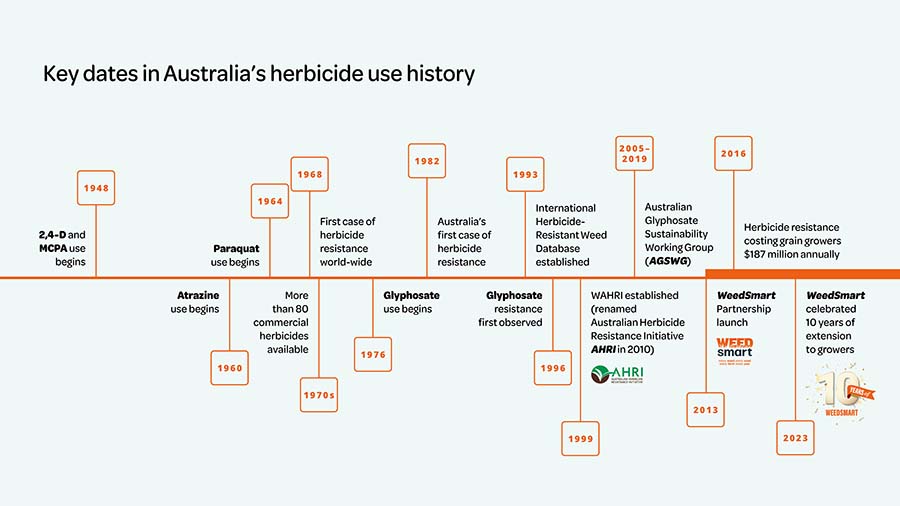WeedSmart was founded in 2013 to engage growers and agronomists in addressing Australia's growing herbicide resistance problem. The industry was concerned that critical messages were inconsistent and that many growers and advisors did not understand the mechanisms of herbicide resistance nor the tactics needed to combat the problem successfully.
WeedSmart’s founding partners, GRDC and Bayer (formerly Monsanto), funded the creation of a unique agricultural extension model to promote sustainable herbicide use through Integrated Weed Management (IWM). Other industry partners quickly added their financial support to the WeedSmart initiative.
The Australian Herbicide Resistance Initiative, based at the University of Western Australia, won the tender to deliver practical and timely information about successfully managing herbicide resistance to growers and agronomists across Australia.
The small team quickly developed the WeedSmart 10 Point Plan, which gave growers a simple checklist to help them implement their own integrated weed management plan, use herbicides sustainably, and take advantage of non-herbicide tactics.
In 2016, the team introduced the WeedSmart Big 6, creating a catchy and easy-to-use reference guide for growers and agronomists planning their cropping and weed management program.
WeedSmart offers a ‘one-stop-shop’ for information on combating weeds in Australian broadacre cropping systems. Farmers and agronomists can engage with science-backed, practical and timely information about keeping weed numbers low and minimising the impact of herbicide resistance on productivity and profits through WeedSmart’s articles, podcasts, grower case studies, videos, webinars, online professional development courses, newsletters and events, such as WeedSmart Week.
Extent of the problem
In 1982, the first cases of herbicide resistance in Australia were observed. Two populations of annual ryegrass (Lolium rigidum) growing on grain farms in Western Australia and South Australia were resistant to multiple herbicide modes of action (MOA). The Western Australian population was resistant to MOA groups 1, 2 and 3, and the South Australian population was resistant to MOA groups 1, 2, 3, 13,15 and 23.
Australia’s agricultural sector has united to establish WeedSmart, an industry-led initiative to enhance on-farm practices and promote the long-term sustainability of herbicide use.
Through WeedSmart, research partners, commercial organisations, government, advisors and growers have joined forces to promote herbicide stewardship and diverse farming and weed management systems on Australian grain and cotton farms.
In 2016, a CSIRO report estimated that weeds cost Australian grain growers $3318 million (or $146/ha) in expenditure ($113/ha) and grain revenue losses ($33/ha) annually. Within this total cost, herbicide resistance cost Australian grain growers $187 million in additional herbicide treatment costs ($8/ha), plus the costs of using extra integrated weed management practices.
Australian growers were spending $475 million or $21/ha (18 per cent of total weed expenditure) on integrated weed management practices for seedling control, other weed seed control and harvest weed seed control.
This report indicated that growers with no herbicide-resistant weeds saved $55/ha in weed management expenses and maximised their yield potential (worth $33/ha) annually.
Implementing the solution
When growers implement the WeedSmart Big 6 management practices, the resulting low weed environment allows them to make business decisions that are no longer dictated by weed pressure.
WeedSmart’s aims are summed up in the statement – ‘More crop, fewer weeds’.
For example:
Western Australian grain grower Gary Lang has taken a proactive approach to weed control on the family’s 5000 hectare farming operation near Wickepin, south east of Perth, in a bid to avoid the management challenges of herbicide resistance.
His strategy is multi-faceted and includes the use of crop competition, strategic crop selection, chaff decking and herbicide applications.
While this has helped drive down the weed seedbank and dramatically reduce weed numbers, Gary is continually looking to instigate further improvement and accessing up-to-date research information is a critical part of ensuring his strategy is as targeted and effective as possible.
“Herbicide resistance represents a significant threat to profitability if you are forced to take country out of production, so we have tried to get on the front foot with our weed management. We want to continue making crop choices that are not dictated by herbicide resistance in weeds,” he said.
“A key part of achieving that is access to research information and industry expertise whether through WeedSmart or a third party like an agronomist; this information underpins every management decision we make.
“The biggest testament to our weed strategies came in 2018 when around 80 per cent of our winter crop was planted before there was any weed germination. So we used very little glyphosate as a knockdown herbicide and suffered minimal yield loss due to weeds which is a fantastic achievement.
“This was mirrored across Western Australia – out of 16 million tonnes of grain harvested state-wide in 2018, probably 12 million tonnes were grown without a knockdown herbicide treatment. That’s what herbicide resistance management is all about.”
Read: GRDC focus delivers gains in herbicide resistance management.
Analysis has shown that GRDC's investment in understanding and combatting herbicide resistance over the past 25 years has returned $3.50 for every dollar invested.
The 2021 Grower Practice Survey showed that growers are adopting alternative methods to control weed seedbanks, including crop-topping, chaff carts, chaff lining, seed impact mills, and spraying under windrows.

Key dates in Australia's herbicide use history. Source: WeedSmart
Recognising the importance of disseminating the outcomes and practical implications of research undertaken by its research partners, GRDC, along with other industry partners, contributes to WeedSmart – an industry-led initiative to enhance on-farm practices and promote the long-term sustainability of herbicide use.
Read: WeedSmart's innovative industry partnership at work.
More information: visit the WeedSmart website.

























































